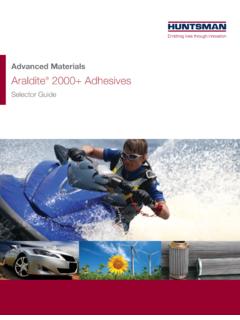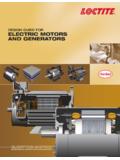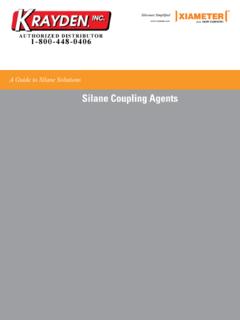Transcription of Carbon Fiber Reinforced Polymer (CFRP) Laminates - Aslan ...
1 !!Hughes Brothers, Inc. 210 N. 13th Street Seward NE 68434 Ph:800-869-0359 2011 Aslan 400 cfrp Laminates Carbon Fiber Reinforced Polymer ( cfrp ) Laminates - Aslan 400 series November 10, 2011 !!2!Hughes Brothers, Inc. 210 N. 13th Street Seward NE 68434 Ph:800-869-0359 2011 Aslan 400 cfrp Laminates Aslan 400 Carbon FRP Laminates are used to structurally strengthen existing concrete, wood, or masonry members in flexure and shear. The Aslan 400 cfrp laminate is a pre-cured plate with a surface texture on one face, which helps improve bond with the structural adhesives. Structures that are deficient due to either a structural flaw, deterioration or because of a change in use can often be brought to a useful capacity using Aslan 400.
2 Externally bonded FRP strengthening is analogous to steel plate bonding. Successful implementation of cfrp plate bonding is dependent on proper surface preparation, leveling and bond of the structural adhesive to the concrete and cfrp plate interfaces. Externally bonded cfrp Laminates work best in overhead applications for flexural strengthening where sufficient bond and development lengths can be achieved. Externally Bonded Structural Strengthening Flexural Strengthening of: - Bridge Decks - Parking Garages - Floor slabs Shear Strengthening Change of Use Situations Higher Loads Return Deteriorated Members to Capacity Additional Structural Capacity Without Additional Dead Weight Benefits of Aslan 400 Carbon FRP laminate Furnished with guaranteed properties based on measured results.
3 Aslan 400 is manufactured in a controlled environment and not subject to vagaries of field wet lay-up systems. Furnished with one face prepared for bonding to adhesive. Much lighter weight than steel plate bonding Will not rust or corrode Can be used with multiple commercially available high strength adhesives.!Since 1993, Hughes Brothers has been at the forefront of worldwide academic and industry efforts to define consensus FRP standards and methods. Hundreds of structures have extended service lives due to Aslan 400 cfrp Laminates .!Masonry Strengthening In Plane and Out of Plane Strengthening of Masonry Shear Walls Event Loading of Masonry Blast, & Seismic Restore Capacities of Cracked Masonry !
4 !3!Hughes Brothers, Inc. 210 N. 13th Street Seward NE 68434 Ph:800-869-0359 2011 Aslan 400 cfrp Laminates Aslan 400 Mechanical Properties Tensile, Modulus & Strain Design Tensile & Modulus Properties Tensile and Modulus Properties are measured per ASTM D3039, Standard Test Method for Tensile Properties of Polymer Matrix Composite Materials. The ultimate tensile load is measured and the tensile modulus is measured at approximately 10% to 50% of the ultimate load. The slope of the stress-strain curve is determined as the tensile modulus. Ultimate Strain is extrapolated from the ultimate load divided by the nominal area and modulus.
5 The area used in calculating the tensile strength is the nominal cross sectional area. The Guaranteed Tensile Strength , f*fu is as defined by ACI as the mean tensile strength of a given production lot, minus three times the standard deviation or f*fu = fu,ave 3 . The Design or Guaranteed Modulus of Elasticity is as defined by ACI as the mean modulus of a production lot or Ef = Ef,ave . Hughes Brothers reserves the right to make improvements in the product and/or process which may result in benefits or changes to some physical-mechanical characteristics. The data contained herein is considered representative of current production and is believed to be reliable and to represent the best available characterization of the product as of July 2011.
6 Tensile tests per ASTM D3039. Dimensions Nominal Area Guaranteed Tensile Strength Ultimate Tensile Load Tensile Modulus of Elasticity Ultimate Strain Width -in Width - mm Thickness - in Thickness - mm mm2 in2 MPa ksi kN kips GPa psi 106 % 2 50 70 2400 350 168 131 19 4 100 140 2400 350 336 131 19 !Net Fiber Area vs. Measured Material Properties There is a great deal of confusion and debate over reporting material properties of FRP strengthening materials. The two methods used are: 1) Net Fiber Area and 2) Gross laminate Area. Net Fiber Area is often used with field wet lay-up systems where the amount of Fiber in an un-cured fabric mat is known but the final thickness of the cured composite with impregnated resin is unknown.
7 The resin is thus excluded from the composite. The strands or fibers are impregnated with resin, cured and then tested in tension. The properties are calculated using the area of the fibers and the area of the resin is ignored. The Gross laminate Area of an FRP system is calculated using the total cross sectional area of the cured composite including all fibers and resin. This gives the appearance that the material has a lower tensile strength. It is important to recognize that the stress is lower but with the larger area the loads are similar. Hughes Brothers reports all material properties based on the Gross laminate Area method using actual production lot tests per ASTM D3039.
8 Since the design procedures in consensus guides such as the ACI limit the strain in the FRP material, the full nominal strength of the FRP is NOT used and should not be the basis of comparison between two FRP systems (from ACI section , pg 43) !!4!Hughes Brothers, Inc. 210 N. 13th Street Seward NE 68434 Ph:800-869-0359 2011 Aslan 400 cfrp Laminates Material Certs Material test certs are available for any production lot of Aslan 400 laminate . Density Aslan 400 Laminates with extensometer and after valid tensile test Transition Temperature of Resin - Tg Known as the glass transition temperature or the temperature at which the resin changes from a glassy state and begins to soften.
9 Tg = 230 F (110 C) Size Designation Unit Weight / length Size mm kg / m lbs / ft 2 50 4 100 !!!5!Hughes Brothers, Inc. 210 N. 13th Street Seward NE 68434 Ph:800-869-0359 2011 Aslan 400 cfrp Laminates ACI Guide for the Design and Construction of Externally Bonded FRP Systems for Strengthening Concrete Structures - Provides authoritative, consensus guidelines for the use of Aslan 400. Design Guidance!ACI Guide for the Design and Construction of Externally Bonded Fiber - Reinforced Polymer Systems for Strengthening Unreinforced Masonry Structures An ACI Emerging Technology Series document provides state of the art guidance for masonry strengthening with Aslan 400.
10 FIB Task Group bulletin 14 Externally bonded FRP reinforcement for RC Structures In Europe, the Federation Internationale du Beton FIB Task Group has published a technical report Bulletin 14 , which is a thorough guide for the design and installation of Aslan 400 cfrp Laminates . CSA S-806 Design and Construction of Building Structures with Fibre- Reinforced Polymers The Canadian guideline includes provisions for externally bonded structural strengthening. As c s fe biAf = n tf wfcd - ch - cffe = Ef feffe = Ef fefsfsdhneutralaxis fc 1 cbReinforced ConcreteSectionStrain DistributionStress Distribution(Non-linear ConcreteStress Distribution)Stress Distribution(EquivalentFictitious ConcreteStress Distribution)!




